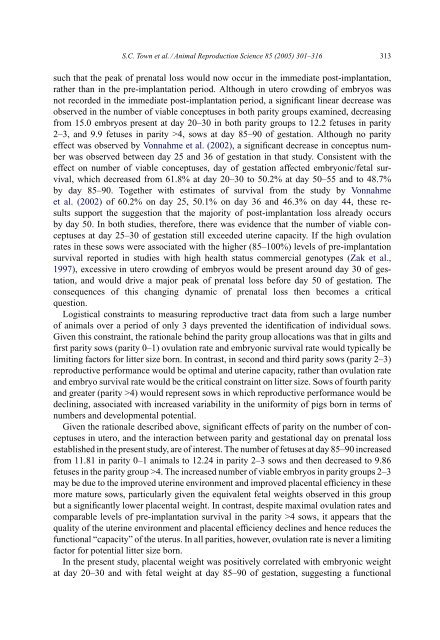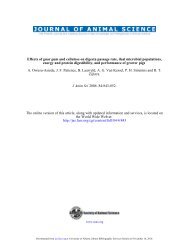Embryonic and fetal development in a commercial dam-line genotype
Embryonic and fetal development in a commercial dam-line genotype
Embryonic and fetal development in a commercial dam-line genotype
Create successful ePaper yourself
Turn your PDF publications into a flip-book with our unique Google optimized e-Paper software.
S.C. Town et al. / Animal Reproduction Science 85 (2005) 301–316 313such that the peak of prenatal loss would now occur <strong>in</strong> the immediate post-implantation,rather than <strong>in</strong> the pre-implantation period. Although <strong>in</strong> utero crowd<strong>in</strong>g of embryos wasnot recorded <strong>in</strong> the immediate post-implantation period, a significant l<strong>in</strong>ear decrease wasobserved <strong>in</strong> the number of viable conceptuses <strong>in</strong> both parity groups exam<strong>in</strong>ed, decreas<strong>in</strong>gfrom 15.0 embryos present at day 20–30 <strong>in</strong> both parity groups to 12.2 fetuses <strong>in</strong> parity2–3, <strong>and</strong> 9.9 fetuses <strong>in</strong> parity >4, sows at day 85–90 of gestation. Although no parityeffect was observed by Vonnahme et al. (2002), a significant decrease <strong>in</strong> conceptus numberwas observed between day 25 <strong>and</strong> 36 of gestation <strong>in</strong> that study. Consistent with theeffect on number of viable conceptuses, day of gestation affected embryonic/<strong>fetal</strong> survival,which decreased from 61.8% at day 20–30 to 50.2% at day 50–55 <strong>and</strong> to 48.7%by day 85–90. Together with estimates of survival from the study by Vonnahmeet al. (2002) of 60.2% on day 25, 50.1% on day 36 <strong>and</strong> 46.3% on day 44, these resultssupport the suggestion that the majority of post-implantation loss already occursby day 50. In both studies, therefore, there was evidence that the number of viable conceptusesat day 25–30 of gestation still exceeded uter<strong>in</strong>e capacity. If the high ovulationrates <strong>in</strong> these sows were associated with the higher (85–100%) levels of pre-implantationsurvival reported <strong>in</strong> studies with high health status <strong>commercial</strong> <strong>genotype</strong>s (Zak et al.,1997), excessive <strong>in</strong> utero crowd<strong>in</strong>g of embryos would be present around day 30 of gestation,<strong>and</strong> would drive a major peak of prenatal loss before day 50 of gestation. Theconsequences of this chang<strong>in</strong>g dynamic of prenatal loss then becomes a criticalquestion.Logistical constra<strong>in</strong>ts to measur<strong>in</strong>g reproductive tract data from such a large numberof animals over a period of only 3 days prevented the identification of <strong>in</strong>dividual sows.Given this constra<strong>in</strong>t, the rationale beh<strong>in</strong>d the parity group allocations was that <strong>in</strong> gilts <strong>and</strong>first parity sows (parity 0–1) ovulation rate <strong>and</strong> embryonic survival rate would typically belimit<strong>in</strong>g factors for litter size born. In contrast, <strong>in</strong> second <strong>and</strong> third parity sows (parity 2–3)reproductive performance would be optimal <strong>and</strong> uter<strong>in</strong>e capacity, rather than ovulation rate<strong>and</strong> embryo survival rate would be the critical constra<strong>in</strong>t on litter size. Sows of fourth parity<strong>and</strong> greater (parity >4) would represent sows <strong>in</strong> which reproductive performance would bedecl<strong>in</strong><strong>in</strong>g, associated with <strong>in</strong>creased variability <strong>in</strong> the uniformity of pigs born <strong>in</strong> terms ofnumbers <strong>and</strong> <strong>development</strong>al potential.Given the rationale described above, significant effects of parity on the number of conceptuses<strong>in</strong> utero, <strong>and</strong> the <strong>in</strong>teraction between parity <strong>and</strong> gestational day on prenatal lossestablished <strong>in</strong> the present study, are of <strong>in</strong>terest. The number of fetuses at day 85–90 <strong>in</strong>creasedfrom 11.81 <strong>in</strong> parity 0–1 animals to 12.24 <strong>in</strong> parity 2–3 sows <strong>and</strong> then decreased to 9.86fetuses <strong>in</strong> the parity group >4. The <strong>in</strong>creased number of viable embryos <strong>in</strong> parity groups 2–3may be due to the improved uter<strong>in</strong>e environment <strong>and</strong> improved placental efficiency <strong>in</strong> thesemore mature sows, particularly given the equivalent <strong>fetal</strong> weights observed <strong>in</strong> this groupbut a significantly lower placental weight. In contrast, despite maximal ovulation rates <strong>and</strong>comparable levels of pre-implantation survival <strong>in</strong> the parity >4 sows, it appears that thequality of the uter<strong>in</strong>e environment <strong>and</strong> placental efficiency decl<strong>in</strong>es <strong>and</strong> hence reduces thefunctional “capacity” of the uterus. In all parities, however, ovulation rate is never a limit<strong>in</strong>gfactor for potential litter size born.In the present study, placental weight was positively correlated with embryonic weightat day 20–30 <strong>and</strong> with <strong>fetal</strong> weight at day 85–90 of gestation, suggest<strong>in</strong>g a functional




